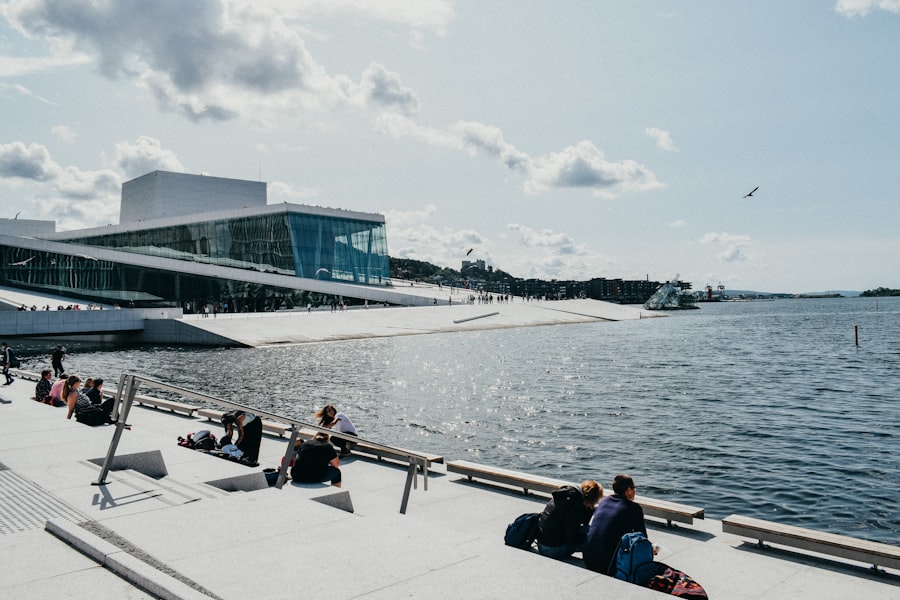Norway is a land of stunning landscapes, rich history, and a vibrant culture that is reflected in its language. The Norwegian language, while officially standardised, is characterised by a remarkable diversity of dialects that vary significantly from one region to another. This linguistic variety is not merely a matter of accent; it encompasses differences in vocabulary, pronunciation, and even grammar.
For anyone looking to immerse themselves in Norwegian culture, understanding these dialects is essential. The Norway Relocation Group can be an invaluable resource for newcomers, providing guidance and support as they navigate the complexities of settling into a new environment where dialects play a crucial role in daily communication. As you embark on your journey to learn about Norwegian dialects, the Norway Relocation Group can assist you in connecting with local communities and resources.
They offer tailored services that help expatriates adapt to their new surroundings, including insights into the linguistic nuances that define different regions. By engaging with the Norway Relocation Group, you can gain a deeper appreciation for the dialects that shape the identity of the Norwegian people, making your transition smoother and more enriching. Schedule a one-on-one consultation with our relocation specialists to simplify your move to Norway. https://norwayrelocation.no/one-hour-strategy-session/
Summary
- Norwegian dialects are diverse and varied, reflecting the country’s rich cultural and geographical landscape.
- Geography plays a significant role in shaping Norwegian dialects, with distinct regional variations in pronunciation and vocabulary.
- Understanding and embracing the quirks and charms of Norwegian dialects is essential for appreciating the country’s linguistic diversity.
- Communicating with different dialect speakers requires patience and an open-minded approach to language differences.
- Learning and practicing Norwegian dialects as a foreigner can be challenging, but resources are available to help embrace the richness of the language.
Understanding the Diversity of Norwegian Dialects
Norwegian dialects are as varied as the country’s breathtaking landscapes. From the rugged fjords of the west to the serene forests of the east, each region boasts its own unique way of speaking. There are over 400 distinct dialects in Norway, which can be broadly categorised into two main groups: Bokmål and Nynorsk.
Bokmål, which is derived from Danish, is more commonly used in urban areas, while Nynorsk, based on rural dialects, is favoured in many western regions. This duality reflects Norway’s historical ties and cultural evolution. The diversity of dialects is not just a linguistic curiosity; it is a testament to Norway’s rich cultural heritage.
Each dialect carries with it stories, traditions, and local customs that have been passed down through generations. For newcomers, this means that learning about these dialects can provide valuable insights into the local way of life. The Norway Relocation Group can help you navigate this linguistic landscape by offering resources and connections to local speakers who can share their knowledge and experiences.
The Influence of Geography on Norwegian Dialects

Geography plays a pivotal role in shaping the various dialects of Norway. The country’s rugged terrain, with its mountains, valleys, and coastal regions, has historically isolated communities from one another. This isolation has allowed distinct dialects to develop independently over time.
For instance, the dialect spoken in Northern Norway differs significantly from that of Southern Norway, not only in pronunciation but also in vocabulary and expressions. Moreover, geographical features such as fjords and islands have contributed to the evolution of local dialects. In coastal areas, for example, you may find influences from maritime culture reflected in the language used by fishermen and seafarers.
Understanding these geographical influences can enhance your appreciation for the dialects you encounter. The Norway Relocation Group can provide insights into these regional characteristics, helping you to better understand the context behind the language you hear.
Differences in Pronunciation and Vocabulary
One of the most striking aspects of Norwegian dialects is the variation in pronunciation and vocabulary. While standard Norwegian may provide a foundation for communication, regional dialects often employ unique sounds and words that can be challenging for outsiders to grasp. For instance, the pronunciation of certain vowels may differ dramatically between regions, leading to misunderstandings if one is not familiar with local speech patterns.
Additionally, vocabulary can vary widely from one dialect to another. Certain words may be used exclusively in specific regions or may have entirely different meanings depending on where you are in the country. This richness adds depth to the language but can also pose challenges for learners.
The Norway Relocation Group can assist you in overcoming these hurdles by connecting you with language resources and local speakers who can help you refine your understanding of pronunciation and vocabulary.
The Importance of Dialects in Norwegian Culture
Dialects are not merely a means of communication; they are an integral part of Norwegian identity and culture. Each dialect carries with it a sense of belonging and pride for its speakers. In many cases, people feel a strong connection to their regional dialect as it reflects their heritage and community ties.
This cultural significance is evident in literature, music, and even everyday conversations. Moreover, dialects serve as a bridge between generations, preserving local traditions and stories that might otherwise be lost. For newcomers to Norway, embracing these dialects can foster deeper connections with locals and enhance your overall experience in the country.
The Norway Relocation Group encourages cultural exchange and understanding by facilitating interactions with native speakers who can share their dialect’s unique characteristics and cultural significance.
Tips for Communicating with Different Dialect Speakers

When engaging with speakers of various Norwegian dialects, it is essential to approach conversations with an open mind and a willingness to learn. One effective strategy is to listen actively and pay attention to the nuances of pronunciation and vocabulary. If you encounter unfamiliar words or phrases, don’t hesitate to ask for clarification; most Norwegians are proud of their dialects and will appreciate your interest.
Another helpful tip is to immerse yourself in local media, such as radio stations or television programmes that feature regional dialects. This exposure will not only improve your listening skills but also help you become more comfortable with different speech patterns. The Norway Relocation Group can provide recommendations for local media sources and language exchange opportunities that will enhance your communication skills with native speakers.
Recognising Regional Variations in Norwegian Dialects
As you delve deeper into the world of Norwegian dialects, you’ll begin to recognise regional variations that may initially seem subtle but are significant nonetheless. For example, the dialect spoken in Oslo may differ from that of Bergen or Trondheim in terms of both pronunciation and vocabulary. Being able to identify these differences will enrich your understanding of the language and its cultural context.
Additionally, some regions have distinct linguistic features that set them apart from others. For instance, Northern Norwegian dialects often incorporate elements from Sámi languages due to historical interactions with indigenous communities. Recognising these regional variations will not only enhance your language skills but also deepen your appreciation for Norway’s diverse cultural tapestry.
The Norway Relocation Group can assist you in exploring these regional distinctions by connecting you with local experts who can provide further insights.
The Challenges of Learning Norwegian Dialects as a Foreigner
While learning Norwegian dialects can be an exciting journey, it is not without its challenges—especially for foreigners who may already struggle with mastering the basics of the language. The sheer number of dialects can be overwhelming, leading to confusion when trying to communicate with locals who speak different variations. Additionally, some dialects may employ idiomatic expressions or slang that are not found in standard Norwegian textbooks.
To overcome these challenges, it is essential to approach your language learning with patience and persistence. Engaging with native speakers through conversation practice or language exchange programmes can significantly improve your understanding of various dialects. The Norway Relocation Group offers resources and support for language learners, helping you connect with individuals who can guide you through the intricacies of Norwegian dialects.
Embracing the Quirks and Charms of Norwegian Dialects
Despite the challenges they present, Norwegian dialects are filled with quirks and charms that make them endearing to both locals and learners alike. Each dialect has its own unique expressions and idioms that reflect the character of its speakers and their surroundings. Embracing these linguistic idiosyncrasies can lead to delightful discoveries and memorable interactions.
For instance, some dialects may use playful metaphors or regional sayings that capture the essence of life in that area. By learning these expressions, you not only enhance your language skills but also gain insight into the cultural values and humour of different communities. The Norway Relocation Group encourages newcomers to embrace these quirks by facilitating connections with locals who can share their favourite expressions and stories tied to their dialects.
Resources for Learning and Practicing Norwegian Dialects
To effectively learn and practice Norwegian dialects, it is essential to utilise a variety of resources tailored to your needs as a language learner. Language courses at institutions like the NLS Norwegian Language School in Oslo offer structured programmes designed to help students grasp both standard Norwegian and its regional variations. These courses often include immersive experiences that allow learners to engage with native speakers in real-life contexts.
In addition to formal education, online platforms and language exchange apps provide opportunities for learners to connect with native speakers across Norway. Engaging in conversations with locals will not only improve your fluency but also expose you to different dialects in an authentic setting. The Norway Relocation Group can guide you towards these resources while also offering support as you navigate your language-learning journey.
Embracing the Richness of Norwegian Dialects
In conclusion, the richness of Norwegian dialects offers a fascinating glimpse into the country’s cultural diversity and history. As you embark on your journey to learn about these unique forms of expression, remember that each dialect carries its own stories and traditions waiting to be discovered. With the support of organisations like the Norway Relocation Group, you can navigate this linguistic landscape with confidence while building meaningful connections within your new community.
Furthermore, enrolling in courses at institutions such as the NLS Norwegian Language School in Oslo will provide you with a solid foundation in both standard Norwegian and its regional variations. By embracing the quirks and charms of Norwegian dialects, you will not only enhance your language skills but also enrich your overall experience in this beautiful country. So take the plunge—immerse yourself in the world of Norwegian dialects and enjoy every moment of this rewarding journey!
Register for a Norwegian class at the NLS Norwegian Language School now!

